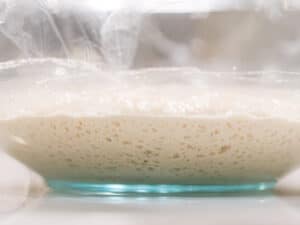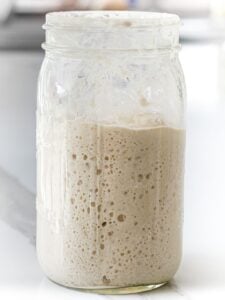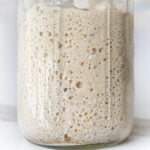Sourdough Starter 2 Ways - Traditional and No-discard method
Learn how to make sourdough starter 2 ways - the traditional method of feeding and discarding & a no-discard method using yeast water!
Servings: 4
Calories: 433kcal
Equipment
Ingredients
Traditional Starter Method - Initial Mix (Day 1)
- 120 g whole rye flour or whole wheat flour - See Note 1
- 120 g filtered water - use warm water if you're in a cold environment
Traditional Starter Method - Daily Feeding (Days 2 to 7)
- 120 g Bread flour
- 120 g filtered water
No-discard Yeast Water Method
- 100 g yeast water
- 100 g Bread flour
- 2 g sea salt - (optional) See Note 2
Instructions
No-discard Yeast Water Method (100% hydration)
- Mix all the yeast water, bread flour, and sea salt in a clear bowl or jar and cover it with plastic wrap. Set it in a warm place for 12 to 14 hours or until it doubles in volume. If you choose not to add the sea salt, it will be ready in less time (around 6 to 8 hours) so keep an eye on it. See Note 2 about adding salt.

- Once it doubles in volume, the starter is ready to use. This makes 200g of starter which is sufficient for most recipes. If you'd like a little leftover to keep in the fridge, increase the amount accordingly.Store any leftovers in the fridge and feed it like you would a regular starter. It will start to develop a sour flavor over time.

Traditional Sourdough Starter Method (100% hydration)
- Day 1: Mix 120g of rye or wheat flour and 120g of filtered water together and add it to a glass jar or bowl and loosely cover it with plastic wrap. Set it in a warm place for 24 hours (74 to 78 degrees F).

- Day 2: Save 120g of the initial mix from Day 1 and discard the rest. Then, add to the initial mix 120g of bread flour and 120g of water. Mix everything together, loosely cover it, and set it in a warm place for 24 hours. We'll be referring to this as your starter. Total amount: 360g of starter.

- Days 3 to 5 (Two discards and feedings per day) - Save 120g of the starter and discard the rest. Then, feed the starter with 120g of bread flour and 120g of water. Mix everything together, loosely cover it, and set it in a warm place for 12 hours. Repeating this step of discarding and feeding 12 hours later.At this point, you should start to see small bubbles and signs of activity in the starter. It will smell like yeast with a very subtle tang. You should end up with 360g of starter at the end of the day.

- Day 6: The starter should be very active and bubbly. It should double in volume 4 to 6 hours after a feeding and smell tangy and like fresh dough. You should see it rise and fall on a regular schedule with each feeding.At this point, you can bake with it or store it in the fridge to slow down the fermentation. If you store it in the fridge, feed it once per week by following the same process: discard all but 120g and feed it 120g of bread flour and 120g of water.If your starter isn't showing signs of activity by day 6, repeat the twice daily discarding and feeding schedule until you start to see it double in volume. It may take longer if you're in a cold environment.

Notes
- Whole rye flour - based on my experience, starters that began with rye flour become active much faster due to the high nutrients found in rye flour. If you don't have rye flour, you can substitute with whole wheat flour. Avoid using bleached flour when making starters.
- Salt in the no-discard yeast water starter - the reason for adding salt to this method is because the yeast water already has a high population of yeast. So, we're able to add salt to delay the fermentation and add more flavor without harming the yeast.
Nutrition
Serving: 360g | Calories: 433kcal | Carbohydrates: 87g | Protein: 14g | Fat: 2g | Saturated Fat: 1g | Sodium: 14mg | Potassium: 120mg | Fiber: 3g | Sugar: 1g | Calcium: 18mg | Iron: 1mg
